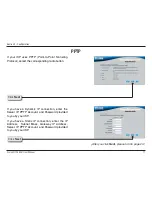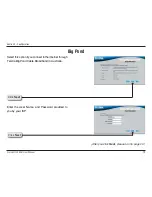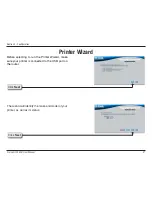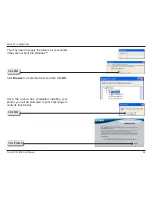
D-Link DI-704GU User Manual
Section - Configuration
The MAC address is optional, but some ISPs may require it, in which case the MAC address of the router must be the
same as the MAC address that is registered with your ISP account. Each networking device has its own unique MAC
address defined by the hardware manufacturer. Some ISP’s record the MAC address of the network adapter in the
computer or router used to initially connect to their service. The ISP will then only grant Internet access to requests from
a computer or router with this particular MAC address. Your new router has a different MAC address than the computer
or router that initially connected to the ISP. The default MAC address of the router is set to the MAC address of the WAN
interface in the device. You can either type in an alternate MAC address (for example, the MAC address of the router
initially connected to the ISP) or copy the MAC address of a PC. To copy the MAC address of the computer that initially
connected to the ISP, connect to the router using that computer and click the
Clone Your PC’s MAC Address
button.
The WAN port will then use the MAC address of the network adapter in your computer.
The IP address of a Domain Name Server. Your ISP will provide this information if it is required; otherwise, leave this box
set to 0.0.0.0.
The IP address of a Domain Name Server. Your ISP will provide this information if it is required; otherwise, leave this box
set to 0.0.0.0.
When the the router detects that the WAN cable has been disconnected, it waits for the “Link Drop Delay” (given in
seconds) before treating the WAN connection as broken. This delay allows you to temporarily remove the WAN cable
without dropping the logical connection to the ISP. It also allows for temporary electrical “glitches” in the physical connection.
Values can range from 0 to 65535 seconds. A value of zero causes immediate disconnection when the cable is pulled
or when a glitch occurs. Having to increase Link Drop Delay because you are experiencing WAN disconnections for long
periods would suggest a fault with the cable or with the modem (if any) to which it is connected.
If this box is left blank, the router selects the usual MTU settings for the type of WAN interface in use. The Maximum
Transmission Unit (MTU) is a parameter that determines the largest packet size (in bytes) that the router will send to the
WAN. If LAN devices send larger packets, the router will break them into smaller packets. Ideally, you should set this to
match the MTU of the connection to your ISP. Typical values are 1500 bytes for an Ethernet connection and 1492 bytes
for a PPPoE connection. If the router’s MTU is set too high, packets will be fragmented downstream. If the router’s MTU
is set too low, the router will fragment packets unnecessarily and in extreme cases may be unable to establish some
connections. In either case, network performance can suffer.
MAC Address:
Primary DNS
Server:
Secondary DNS
Server:
Link Drop Delay:
MTU:
Содержание DI-704GU
Страница 1: ......
Страница 66: ...66 D Link DI 704GU User Manual Section 2 Configuration Help ...
















































